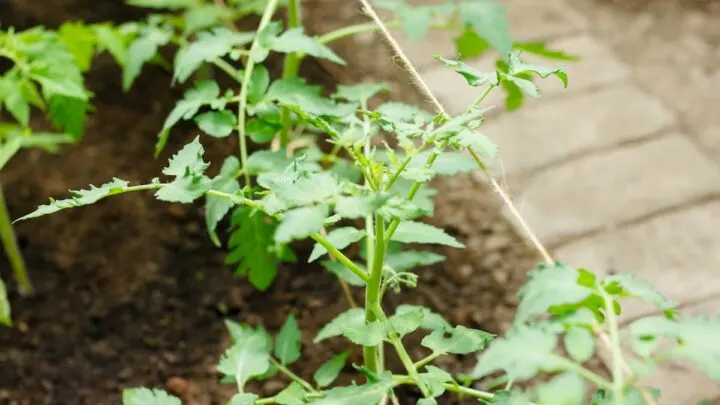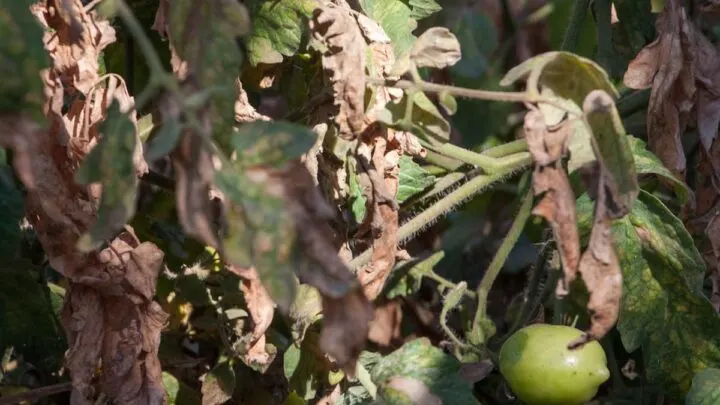Tomato plants are a must-have in the garden. We rely on a bountiful tomato crop more than we probably realize. All those plans of making batches of tomato sauce or salsas disappear when we realize something may be wrong with the plants that can affect the harvest. It’s not uncommon for tomato plants to lose leaves. However, tomato plants that lose leaves rapidly and in large quantity are alarming and a cause for concern. So, what causes tomato leaves to fall off?
Tomato leaves can fall off due to lack of water and bacterial wilt. Other causes include nutrient deficiencies, especially nitrogen. Low temperatures can also cause tomato leaves to fall off.

Symptoms that accompany falling leaves
1. Wilting – Fallen leaves accompanied by leaves that look droopy and dry soil indicate that the plant is not getting enough water.
Treatment and prevention – Tomato plants need to be watered regularly. Unlike other crops like potatoes which can be drought-tolerant, tomatoes are very easily stressed, and they show it. Most recommendations are that tomatoes should be watered once daily and twice on hot days. This is a general recommendation.
Some plants will need more or less watering. Let the soil be an indicator. Tomato plants in raised beds and containers dry out more easily. Mulching tomato plants with straw helps keep moisture in for longer periods. It prevents the sun from causing water on the soil surface to evaporate quickly. Always water at the base of the plant and give that tomato plant a good drink.
2. Tomato Wilting diseases – Another reason for falling leaves with drooping is wilting diseases. Bacteria in the soil cause them. Some strains of bacteria are vigorous and will eventually kill the plant. Since there are several wilting diseases, we’ll look at the differences to better identify which type might affect your plant.
Bacterial wilt – Part of the tomato plant appears wilted for a few hours during the hottest part of the day, then perk up at some point. The leaves don’t discolor, and leaf drop isn’t a common symptom since the whole plant will drop dead suddenly.
Fusarium wilt – Like bacterial wilt, part of the tomato plant appears wilted during the hottest part of the day and later perks up as the weather cools. The leaves, in this case, will be yellow, starting with the bottom branches and then falling off. The wilting and discoloration occur on one side of the plant before progressing throughout the whole plant. This is more likely to occur during hot weather.
Verticillium wilt – Mild wilting occurs in this case, with leaves perking up overnight. Telltale signs of verticillium wilt are distinctive v-shaped lesions on the leaves due to discoloration occurring between the veins of the leaves. The discoloration will also be present in the plant’s stems.

3. Discoloration – Leaves that lighten in color from green to pale green, or a bright yellow-green is usually an indicator of a nitrogen deficiency.
Treatment and Prevention– Getting a soil test is best to confirm a nutrient deficiency or catch it early. Since soil tests take time, getting one when a plant is already in distress isn’t feasible. Add a fertilizer specifically made for tomatoes. Apply according to the instructions.
Do not over-apply to compensate for a suspected deficiency. Granular fertilizers are slowly released, so it may take several weeks before the plant shows improvement. A liquid fertilizer will deliver the nitrogen more rapidly.
Get a soil test every year. Many universities with an agricultural department and state agriculture agencies offer these tests at low cost or for free. Test results will often come with advice on fixing issues found in the soil samples you sent in.
4. Spotted leaves – Septoria leaf spot eventually causes leaves to drop. It is caused by fungi that thrive in humid conditions. Telltale signs are yellowing leaves with dark, ugly spots with light or cream-colored centers. The plant’s lower leaves are affected first, and infection gradually moves upwards to the entire plant. This condition is deadly, and any actions to treat the disease must be quick and sometimes drastic.
Treatment and prevention- Remove all infected leaves. If a lot of leaves have to be removed, it may result in an awful looking plant, but it’s essential for trying to save the plant. Remember that new leaves will grow. Throw infected leaves directly in the trash, do not compost them.
Wash your hands and use alcohol to sterilize any tools to clip off leaves. This will prevent the spreading of the disease to other plants. While Septoria leaf spot primarily affects tomatoes, other nightshades growing nearby, such as eggplants, can become infected.
If most of the plant is already infected, pull up the entire plant and throw it away. Apply a fungicidal spray to the leaves that do not show signs of infection. Another step to treat or prevent Septoria is to reduce humidity amongst plants. Increase airflow by trimming off dense foliage. This will create spaces where air can flow freely.

Always water the soil and not the leaves. Water left sitting on plant leaves promotes fungal growth. You can also reduce fungal spores by weeding around tomato plants, as weeds can also be infected and spread disease. Use a straw mulch to prevent soil from splashing onto leaves when you water the plants or when there are rainfalls.
5. Missing foliage – If you notice leaf drop and, on closer inspection of the plant, realize that some branches are stripped clean, you may have hornworms. Hornworms are fat green caterpillars that enjoy eating tomato plants. They camouflage very well, so it may take some time before you spot them.
Treatment and prevention – The simplest way to get rid of hornworms is to pick them off the plant and drop them into a bucket of soapy water. If picking caterpillars is not your thing, you can try applying a pesticide spray. A combination of both methods is probably the most effective.
A wasp has laid eggs on it if you come across a hornworm with an unappealing cluster of white, rice-like structures on its back. These wasps are beneficial insects, so you may choose not to kill that hornworm. At some point, the hornworm will die because the growing wasp larvae will feed on it.
Final Thoughts
So, what if none of the symptoms above fit what you are experiencing with your tomatoes. Thinking back to what events preceded the leaf drop will help troubleshoot what might be wrong.
Perhaps temperatures dipped too low overnight. Was the plant recently transplanted outdoors, or could an animal have gotten to it? These are usually just one-time events. Falling leaves can be alarming, but if the plant looks normal and healthy, you may just be experiencing normal leaf drops.

Hi there, my name is Allie and welcome to my blog; GareningWithAllie!
Much of what you see written here is just our personal experiences with gardening. Along with the content I write here, there is also a unique collection of gardening topics covered by some of our close friends. I hope you find everything you read here to be helpful, informative, and something that can make your gardening journey the most lovely experience ever! With that said, Happy Gardening!
